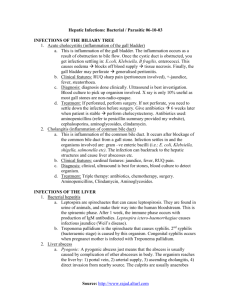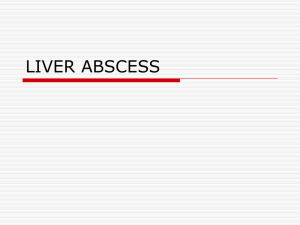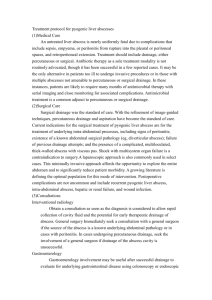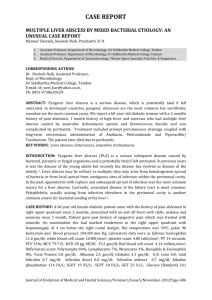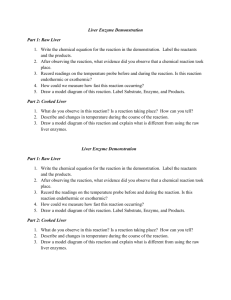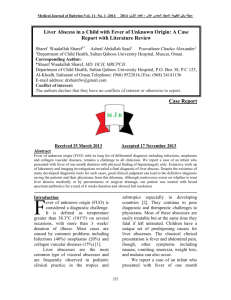Multiple Liver Abscess by Mixed Bacterial Etiology: An
advertisement
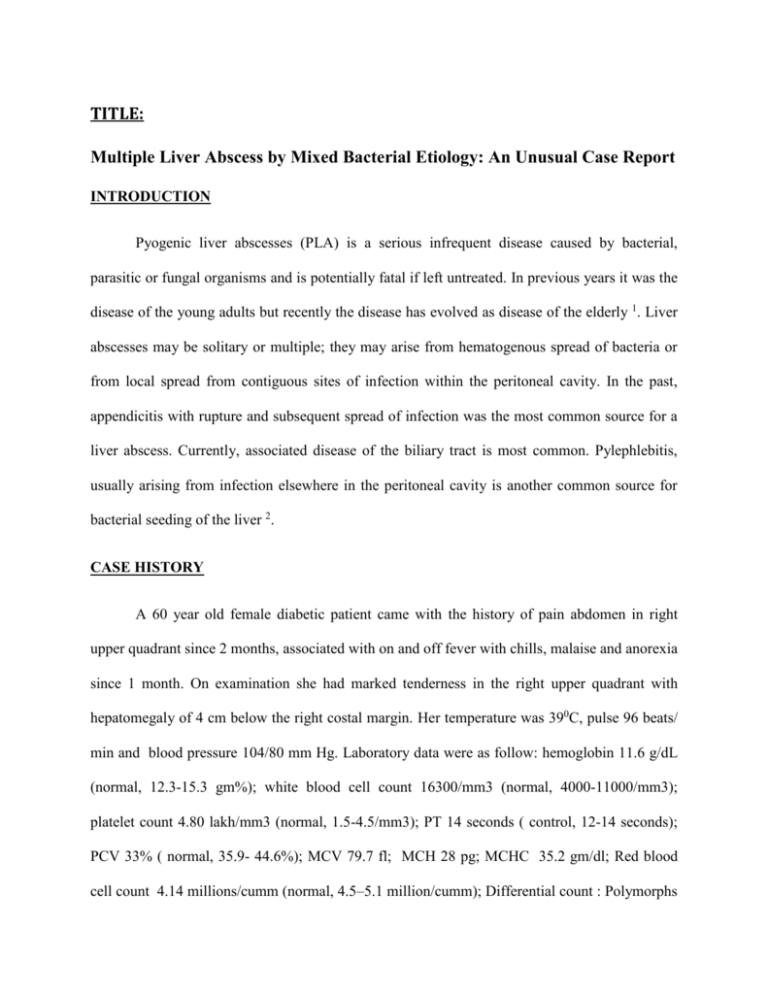
TITLE: Multiple Liver Abscess by Mixed Bacterial Etiology: An Unusual Case Report INTRODUCTION Pyogenic liver abscesses (PLA) is a serious infrequent disease caused by bacterial, parasitic or fungal organisms and is potentially fatal if left untreated. In previous years it was the disease of the young adults but recently the disease has evolved as disease of the elderly 1. Liver abscesses may be solitary or multiple; they may arise from hematogenous spread of bacteria or from local spread from contiguous sites of infection within the peritoneal cavity. In the past, appendicitis with rupture and subsequent spread of infection was the most common source for a liver abscess. Currently, associated disease of the biliary tract is most common. Pylephlebitis, usually arising from infection elsewhere in the peritoneal cavity is another common source for bacterial seeding of the liver 2. CASE HISTORY A 60 year old female diabetic patient came with the history of pain abdomen in right upper quadrant since 2 months, associated with on and off fever with chills, malaise and anorexia since 1 month. On examination she had marked tenderness in the right upper quadrant with hepatomegaly of 4 cm below the right costal margin. Her temperature was 390C, pulse 96 beats/ min and blood pressure 104/80 mm Hg. Laboratory data were as follow: hemoglobin 11.6 g/dL (normal, 12.3-15.3 gm%); white blood cell count 16300/mm3 (normal, 4000-11000/mm3); platelet count 4.80 lakh/mm3 (normal, 1.5-4.5/mm3); PT 14 seconds ( control, 12-14 seconds); PCV 33% ( normal, 35.9- 44.6%); MCV 79.7 fl; MCH 28 pg; MCHC 35.2 gm/dl; Red blood cell count 4.14 millions/cumm (normal, 4.5–5.1 million/cumm); Differential count : Polymorphs 90%, Lymphocytes 7%, Monocytes 3%, Basophils & Eosinophils 0%; Total Protein 5.8 gm /dl (normal, 6.3 – 8.2 gm/dl); Albumin 2.5 gm/dl (normal, 3.4-4.8 gm/dl); Globulin 3.3 gm/dl (normal, 2.3 – 3.5gm/dl); A/G ratio 0.8 ( normal, 1.3 – 1.4 ); total bilirubin 0.7 mg/dl (normal, 0.2 – 1.3mg/dl); bilirubin direct 0.0 ( normal, 0.0 – 0.3 mg/dl); bilirubin indirect 0.7 mg/dl (normal, 0.0 – 1.1 mg/dl); Alkaline phosphatase 114 IU/L (normal, 38 -1216 IU/L); SGOT 19 IU/L; SGPT 18 IU / L; GGT 23 U/L; Glucose (Random) 161 mg/dl ( normal, 70 – 150 mg/dl); PPBS 200 mg/dl; urine analysis was normal except for presence of 8 – 10 pus cell/ hpf and traces of albumin. Ultrasonography of the abdomen revealed that there was a well defined hypoechoic lesion with internal debris in right lobe of liver with sub capsular collection in the right lobe, suggesting the presence of abscess with subcapsular extention. CT scan of the abdomen confirmed the presence of multiple irregular abscesses varying in size, predominantly in the right lobe of the liver. A definitive diagnosis was made when an Actinomyces species and Enterococci species was cultured from aspirated pus by conventional method. The patient was treated by percutaneous drainage and with long-term intravenous administration of amikacin, metronidazole and piperacillin/tazobactam and there was a satisfactory response to treatment. DISCUSSION The microorganisms most often recovered from the pyogenic liver abscess are Escherichia coli, anaerobic Streptococci, gram negative bacilli, Bacteroides fragilis, Staphylococcus aureus, Clostridium species etc., but the incidence varied considerably among previous reports. Pyogenic liver abscess were more commonly seen in elderly patients and in patients with diabetes mellitus. The abscesses were mostly single and located more frequently in right lobe of the liver 1, 3 . Multiple liver abscess are not frequently reported in the literature. The overall mortality rate of pyogenic liver abscess is 11%- 31% and the mortality rate is high in patients with multiple liver abscess. Patient’s with diabetes mellitus, immune deficiency, sickle cell anemia, malignancy and liver transplants are at greater risk for developing liver abscess. In the majority of the cases more than one organism has been isolated from their abscesses. Without appropriate diagnosis and treatment, the pyogenic liver abscess are almost uniformly fatal. Early diagnosis as well as treatment with appropriate antibiotics and selective drainage can subsequently reduce the mortality 4. A high incidence of anaerobic microorganisms (15-46%) as the cause of liver abscess has been reported recently and because of this high incidence, antibiotics effective against anaerobes and aerobic microorganisms should be used in all patients 3, 5 . CT scan is probably the most useful aid in diagnosing and localizing hepatic abscesses 6. Biliary tract disease is the etiology of the abscess in most cases, but sometimes the origin remains unidentified 7. In our case the cause of multiple liver abscess is probably due to extention from the perforation and extention of pus from healed peptic ulcer. Hepatic actinomycosis should be considered in the differential diagnoses of pyogenic liver abscess, space-occupying lesions of the liver and Pyrexia of Unknown Origin in case of elderly patients. CONCLUSION In summary, multiple liver abscess due to Actinomycetes, aerobic and anaerobic bacteria is a rare entity, but a life threatening disease. It requires timely recognition using CT Scan and guided aspiration to start an early and specific therapy to prevent mortality among high risk and elderly patients. REFERENCES 1. Galdfelter T, Brooks M. Liver abscess. JMSMA 1981;7:173-4. 2. Baron MJ, Kasper DL. Intraabdominal infections and abscesses. In: Longo DL, Fauci AS, Kasper DL, editors. Harrison’s principles of internal medicine. 18th ed. USA: Mc Graw Hill; 2010. P. 1077-83. 3. Ergas D, Hai AA, Sthoeger Z, Menahem BH, Miller R. Multiple pyogenic liver abscesses following hemorrhoid banding. IMAJ 2007;9:753-4. 4. Bahloul M, Chaari A, Khlaf NB, Kallel H, Herguefi L, Chelly H, et al. Multiple pyogenic liver abscess. World J Gastroenterol 2006;12(18):2962-3. 5. Alvarez JA, Baldonedo RF, Bear IG, Jorge JL. Anaerobic liver abscesses as initial presentation of silent colonic cancer. HPB ( Oxford) 2004;6(1):41-42. 6. Tzur T, Liberman S, Felzenstein I, Cohen R, Rivkind AI, Almogy G . Liver abscesses caused by Streptococcus milleri: An uncommon presenting sign of silent colonic cancer. IMAJ 2003;5:206-7. 7. Wang YJ, WenSC, Chien ST, King J, Hsuea CW, Feng NH. Liver abscess secondary to sigmoid diverticulitis. A case report. J Intern Med Taiwan 2005;16:289-94.
